语言学考试要点(考试重点整理)
语言学概论考试重点难点
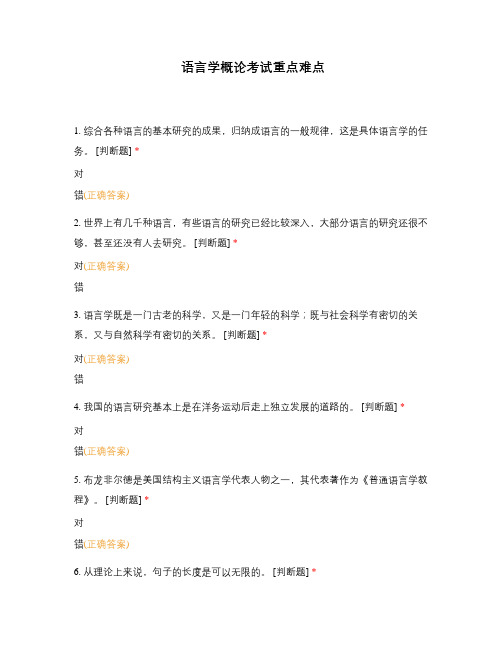
语言学概论考试重点难点1. 综合各种语言的基本研究的成果,归纳成语言的一般规律,这是具体语言学的任务。
[判断题] *对错(正确答案)2. 世界上有几千种语言,有些语言的研究已经比较深入,大部分语言的研究还很不够,甚至还没有人去研究。
[判断题] *对(正确答案)错3. 语言学既是一门古老的科学,又是一门年轻的科学;既与社会科学有密切的关系,又与自然科学有密切的关系。
[判断题] *对(正确答案)错4. 我国的语言研究基本上是在洋务运动后走上独立发展的道路的。
[判断题] *对错(正确答案)5. 布龙非尔德是美国结构主义语言学代表人物之一,其代表著作为《普通语言学教程》。
[判断题] *对错(正确答案)6. 从理论上来说,句子的长度是可以无限的。
[判断题] *对(正确答案)错7. 语言是在文字基础之上产生的人类最重要的交际工具。
[判断题] *对错(正确答案)8. 文字始终是从属于语言的。
[判断题] *对(正确答案)错9. 在一定的条件下,身势等伴随动作也可以脱离语言而独立完成一些交际任 [判断题] *对(正确答案)错10. 现代社会通的方式很多,语言的重要性正日渐削弱。
[判断题] *对错(正确答案)11. 我们常听人们说“工人有工人的语言,农民有农民的语言”,这说明语言是有阶级性的。
[判断题] *对错(正确答案)12. 语言是组成社会的一个不可缺少的因素。
[判断题] *对(正确答案)错13. 现代汉语无论是在词汇的数量上还是表达方式上,都要比古代汉语丰富的多,这说明语言是和生产力发展水平有关的。
[判断题] *对错(正确答案)14. 会不会说话是人类和动物的根本区别之一。
[判断题] *对(正确答案)错15. 语言和思维是两种独立的现象,但它们又形影相随,不可分离。
[判断题] *对(正确答案)错16. 语言是人类最重要的交际工具。
[判断题] *对(正确答案)错17. 文字也是人类最重要的交际工具。
语言学概论考试重点
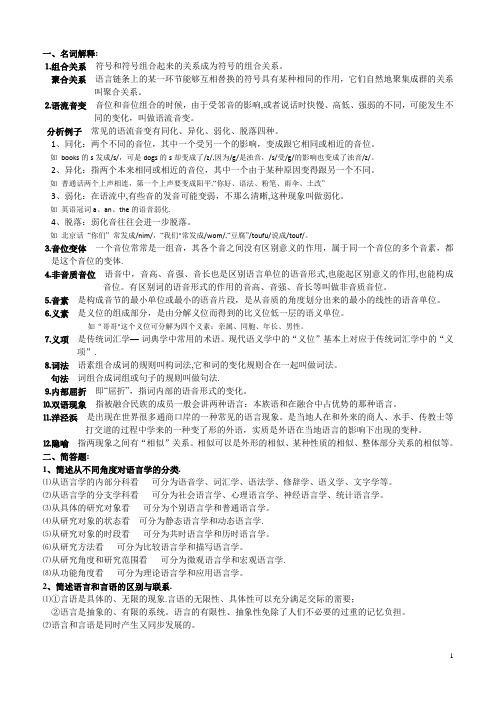
一、名词解释:⒈组合关系符号和符号组合起来的关系成为符号的组合关系。
聚合关系语言链条上的某一环节能够互相替换的符号具有某种相同的作用,它们自然地聚集成群的关系叫聚合关系。
⒉语流音变音位和音位组合的时候,由于受邻音的影响,或者说话时快慢、高低、强弱的不同,可能发生不同的变化,叫做语流音变。
分析例子常见的语流音变有同化、异化、弱化、脱落四种。
1、同化:两个不同的音位,其中一个受另一个的影响,变成跟它相同或相近的音位。
如books的s发成/s/,可是dogs的s却变成了/z/,因为/g/是浊音,/s/受/g/的影响也变成了浊音/z/。
2、异化:指两个本来相同或相近的音位,其中一个由于某种原因变得跟另一个不同。
如普通话两个上声相连,第一个上声要变成阳平.“你好、语法、粉笔、雨伞、土改”3、弱化:在语流中,有些音的发音可能变弱,不那么清晰,这种现象叫做弱化。
如英语冠词a、an、the的语音弱化.4、脱落:弱化音往往会进一步脱落。
如北京话“你们”常发成/nim/,“我们"常发成/wom/,“豆腐”/toufu/说成/touf/。
⒊音位变体一个音位常常是一组音,其各个音之间没有区别意义的作用,属于同一个音位的多个音素,都是这个音位的变体.⒋非音质音位语音中,音高、音强、音长也是区别语言单位的语音形式,也能起区别意义的作用,也能构成音位。
有区别词的语音形式的作用的音高、音强、音长等叫做非音质音位。
⒌音素是构成音节的最小单位或最小的语音片段,是从音质的角度划分出来的最小的线性的语音单位。
⒍义素是义位的组成部分,是由分解义位而得到的比义位低一层的语义单位。
如“哥哥"这个义位可分解为四个义素:亲属、同胞、年长、男性。
⒎义项是传统词汇学—-词典学中常用的术语。
现代语义学中的“义位”基本上对应于传统词汇学中的“义项”.⒏词法语素组合成词的规则叫构词法,它和词的变化规则合在一起叫做词法。
句法词组合成词组或句子的规则叫做句法.⒐内部屈折即“屈折”,指词内部的语音形式的变化。
自考汉语言文学语言学概论复习重点考点

1、历史语言学:主要用历史的方法研究某种语言的短期的和长期的变化规律,如汉语史、英语史。
2、共时语言学:研究语言在某一时期的相对静止的情况,如现代汉语。
3、普通语言学:研究对象是人类语言,着重从理论上探讨语言的共同特点和一般规律,也叫一般语言学。
4、语言:是做为交际工具和思维工具的音义结合的符号系统。
5、言语:就是个人讲话(写作)的行为和结果。
6、组合关系:语言符号与符号之间组成的言语链条关系。
7、聚合关系:在链条某一环节上能够互相替换的,具有相同作用的符号聚积成类的关系。
8、语言的层级性:语言是一个层级的装置,该装置有两层三级,底层是一套音位的聚合类,有音无义.上层是语素以及语素组合成的词,词组合成的句子三级。
9、语言的渐变性:是指语言结构系统只能按照量变到质变的规律逐渐地变化,采取渐变的而不是突变的方式.10、语言的参差性:是指语言结构系统的各要素发展的速度是不整齐的。
非基本词汇及其词义发展最快,语音变化较慢。
11、语言的分化:语言在发展过程中,一种语言逐渐分化为几种语言或方言的现象。
12、语言的混合:几种语言系统混合成一种语言的现象。
13、语言的融合:一种言语战胜另一种语言或一种语言被另一种语言吞噬的现象。
14、频率:是发音体每秒钟振动的次数,它决定声音的高低.15、乐音:基音中的频率和陪音的频率之音存在着整倍数的比例关系时所形成的音会形成有周期性重复的复合波,这种复合波叫乐音。
语音中的元音属于元音。
16、音素:人类在一次发音中从音质角度切分出来的最小的语音单位。
17、音位:是具体语言或方言在一类发音中从能否区别词或语素的角度划分或归并出来的最小的语音形式。
18、音位变体:可归并为同一个音位的各个音素。
19、音位的区别:能够区别音位的语音特征,一般具有二元对立的特点.20、语义:是用语音形式表现出来的语言单位的内容以及语言单位在使用时所表现出来的含义,是人脑对客观事物或现象的概括反映。
21、义素:是对义项进行分析得到的最小的语义特征。
语言学概论自学考试 知识点总结 详细版
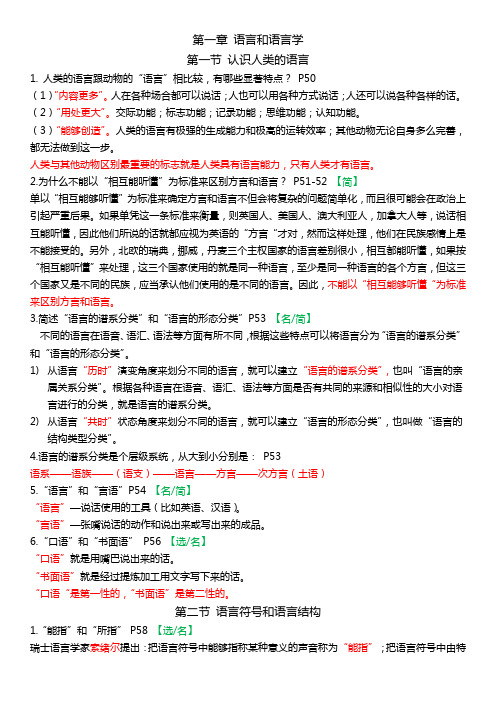
第一章语言和语言学第一节认识人类的语言1.人类的语言跟动物的“语言”相比较,有哪些显著特点?P50(1)“内容更多”。
人在各种场合都可以说话;人也可以用各种方式说话;人还可以说各种各样的话。
(2)“用处更大”。
交际功能;标志功能;记录功能;思维功能;认知功能。
(3)“能够创造”。
人类的语言有极强的生成能力和极高的运转效率;其他动物无论自身多么完善,都无法做到这一步。
人类与其他动物区别最重要的标志就是人类具有语言能力,只有人类才有语言。
2.为什么不能以“相互能听懂”为标准来区别方言和语言?P51-52【简】单以“相互能够听懂”为标准来确定方言和语言不但会将复杂的问题简单化,而且很可能会在政治上引起严重后果。
如果单凭这一条标准来衡量,则英国人、美国人、澳大利亚人,加拿大人等,说话相互能听懂,因此他们所说的话就都应视为英语的“方言“才对,然而这样处理,他们在民族感情上是不能接受的。
另外,北欧的瑞典,挪威,丹麦三个主权国家的语言差别很小,相互都能听懂,如果按“相互能听懂”来处理,这三个国家使用的就是同一种语言,至少是同一种语言的各个方言,但这三个国家又是不同的民族,应当承认他们使用的是不同的语言。
因此,不能以“相互能够听懂“为标准来区别方言和语言。
3.简述“语言的谱系分类”和“语言的形态分类”P53【名/简】不同的语言在语音、语汇、语法等方面有所不同,根据这些特点可以将语言分为“语言的谱系分类”和“语言的形态分类”。
1)从语言“历时”演变角度来划分不同的语言,就可以建立“语言的谱系分类”,也叫“语言的亲属关系分类”。
根据各种语言在语音、语汇、语法等方面是否有共同的来源和相似性的大小对语言进行的分类,就是语言的谱系分类。
2)从语言“共时”状态角度来划分不同的语言,就可以建立“语言的形态分类”,也叫做“语言的结构类型分类”。
4.语言的谱系分类是个层级系统,从大到小分别是:P53语系——语族——(语支)——语言——方言——次方言(土语)5.“语言”和“言语”P54 【名/简】“语言”—说话使用的工具(比如英语、汉语)。
语言学纲要期末考试重点
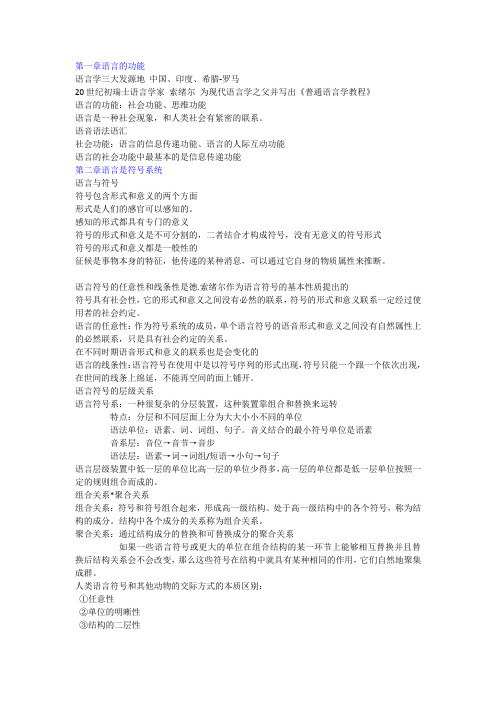
第一章语言的功能语言学三大发源地中国、印度、希腊-罗马20世纪初瑞士语言学家索绪尔为现代语言学之父并写出《普通语言学教程》语言的功能:社会功能、思维功能语言是一种社会现象,和人类社会有紧密的联系。
语音语法语汇社会功能:语言的信息传递功能、语言的人际互动功能语言的社会功能中最基本的是信息传递功能第二章语言是符号系统语言与符号符号包含形式和意义的两个方面形式是人们的感官可以感知的。
感知的形式都具有专门的意义符号的形式和意义是不可分割的,二者结合才构成符号,没有无意义的符号形式符号的形式和意义都是一般性的征候是事物本身的特征,他传递的某种消息,可以通过它自身的物质属性来推断。
语言符号的任意性和线条性是德.索绪尔作为语言符号的基本性质提出的符号具有社会性,它的形式和意义之间没有必然的联系,符号的形式和意义联系一定经过使用者的社会约定。
语言的任意性:作为符号系统的成员,单个语言符号的语音形式和意义之间没有自然属性上的必然联系,只是具有社会约定的关系。
在不同时期语音形式和意义的联系也是会变化的语言的线条性:语言符号在使用中是以符号序列的形式出现,符号只能一个跟一个依次出现,在世间的线条上绵延,不能再空间的面上铺开。
语言符号的层级关系语言符号系:一种很复杂的分层装置,这种装置靠组合和替换来运转特点:分层和不同层面上分为大大小小不同的单位语法单位:语素、词、词组、句子。
音义结合的最小符号单位是语素音系层:音位→音节→音步语法层:语素→词→词组/短语→小句→句子语言层级装置中低一层的单位比高一层的单位少得多,高一层的单位都是低一层单位按照一定的规则组合而成的。
组合关系*聚合关系组合关系:符号和符号组合起来,形成高一级结构。
处于高一级结构中的各个符号,称为结构的成分。
结构中各个成分的关系称为组合关系。
聚合关系:通过结构成分的替换和可替换成分的聚合关系如果一些语言符号或更大的单位在组合结构的某一环节上能够相互替换并且替换后结构关系会不会改变,那么这些符号在结构中就具有某种相同的作用,它们自然地聚集成群。
自考汉语言文学语言学概论复习重点考点

自考汉语言文学语言学概论复习重点考点
一、语言学的基本概念
1.语言学的定义:语言学是研究语言的科学。
2.语言学的分类:一般语言学、历史语言学、实用语言学等。
3.语言学研究的内容:语音学、语法学、词汇学、语义学、语用学等。
二、语音学
1.国际音标:常用国际音标及其音值。
2.语音的分类:元音、辅音等。
3.语音的产生:空气流动、声带振动等。
三、语法学
1.句子成分:主语、谓语、宾语等。
2.句子结构:简单句、复合句等。
3.短语的分类:名词短语、动词短语、形容词短语等。
四、词汇学
1.词的定义:具有独立意义的语言单位。
2.词的分类:实词、虚词等。
3.词的构词法:前缀、后缀等。
五、语义学
1.意义的概念:语言单位所表示的概念。
2.意义的分类:词义、句义、上下文义等。
3.意义的变化:词义的扩大和缩小等。
六、语用学
1.语用学的概念:研究语言实际使用情况的学科。
2.语用学的要素:语言行为、语用规则等。
3.语用失误:歧义、言外之意等。
七、其他
1.汉语言文字的演变:甲骨文、小篆、楷书等。
2.语言与社会文化的关系:语言的社会属性、语言的地位等。
3.语言变异现象:方言、行话、新词等。
以上是自考汉语言文学语言学概论的复习重点和考点,希望能对您的复习有所帮助。
语言学纲要期末考试重点
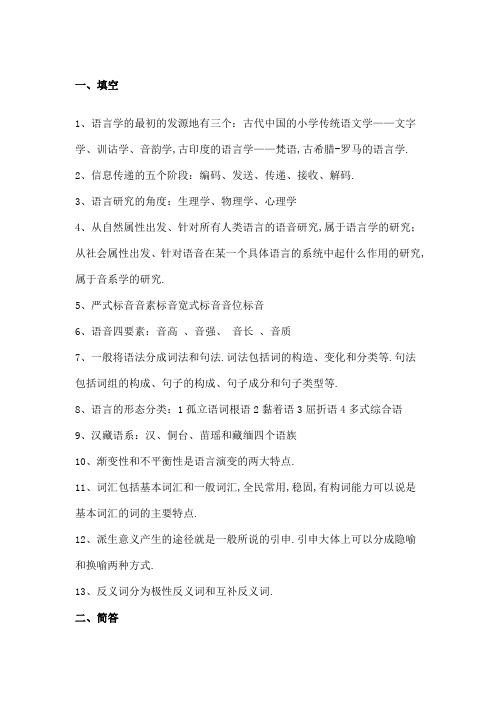
一、填空1、语言学的最初的发源地有三个:古代中国的小学传统语文学——文字学、训诂学、音韵学,古印度的语言学——梵语,古希腊-罗马的语言学.2、信息传递的五个阶段:编码、发送、传递、接收、解码.3、语言研究的角度:生理学、物理学、心理学4、从自然属性出发、针对所有人类语言的语音研究,属于语言学的研究;从社会属性出发、针对语音在某一个具体语言的系统中起什么作用的研究,属于音系学的研究.5、严式标音音素标音宽式标音音位标音6、语音四要素:音高、音强、音长、音质7、一般将语法分成词法和句法.词法包括词的构造、变化和分类等.句法包括词组的构成、句子的构成、句子成分和句子类型等.8、语言的形态分类:1孤立语词根语2黏着语3屈折语4多式综合语9、汉藏语系:汉、侗台、苗瑶和藏缅四个语族10、渐变性和不平衡性是语言演变的两大特点.11、词汇包括基本词汇和一般词汇,全民常用,稳固,有构词能力可以说是基本词汇的词的主要特点.12、派生意义产生的途径就是一般所说的引申.引申大体上可以分成隐喻和换喻两种方式.13、反义词分为极性反义词和互补反义词.二、简答1、语言的社会功能语言的社会功能体现在语言是人类最重要的交通工具.1、语言的信息传递功能.语言是一种社会现象,和人类社会有紧密的联系.语言是组成社会的一个不可缺少的因素.语言的社会功能中最基本的是信息传递功能.这一功能体现在语言上就是内容的表达.语言所能传递的信息可以没有穷尽,信息内容可以跨越时空.语言是人类社会信息传递第一性的、最基本的手段.在信息传递过程中,人们还可以借助语言之外的其他形式,如文字、旗语、信号灯等,但他们大多是语言或文字的再编码系统,自身有较大的局限性.2、语言的人际互动功能.语言的社会功能的另一个重要方面是建立或保持某种社会关联,这可称为语言的人际互动功能.互动包括两个方面:一个是说话者在话语中表达自己的情感、态度、意图;另一方面这些又对受话者施加了影响,得到相应的语言或行动上的反馈,从而达到某种实际效果.2、语言和言语的区别和联系一、区别.1、定义:言语是个人说话的行为和结果.语言是从言语中概括出来被社会所公认的一套语音、词汇和语法的规则的总和.2、语言系统是社会共有的交际工具,因而是稳定的,具有相对静止的状态;言语是人们运用这个工具进行交际的过程和结果,是自由结合的,具有运动状态.3语言是社会的,言语是个人的.语言是个系统,是社会共有的交际工具,社会因素是语言的本质因素.言语是人们运用这个工具说和写的过程和结果,因此,除了具有社会因素外,还具有个人因素.二、联系.1言语是第一性的,语言是第二性的,语言存在于言语当中,言语是语言的存在形式.2语言是抽象的规则,言语是语言具体的运用.3语言来源于言语,又反过来作用于言语.3、符号和征候区别1 征候——事物本身的特征,和本体具有因果关系的自然联系.“础润而雨,月晕而风”,桂花飘香——桂花开放,鼻塞、发烧——感冒.2符号是一个社会全体成员共同约定用来表示某种意义的记号、标记.包括形式和意义两个方面的要素,是一定的形式和一定的内容的统一体,二者缺一不可.符号的形式和意义之间没有本质上的、自然属性上的必然联系.4、语言符号的特征(1)、任意性.也叫约定俗成性,是指作为符号系统的成员,单个语言符号的语音形式和意义之间没有自然属性上的必然联系,只有社会约定的关系.语言符号最突出的特点就是它的音义结合的任意性.2、线条性.是指语言符号在使用中是以符号序列的形式出现,符号只能一个跟着一个依次出现,在时间的线条上绵延,不能在空间的面上铺开.3、强制性.符号一旦进入交际,也就是某一语音形式与某一意义结合起来,表示某一特定的现实现象以后,它对使用的人来说就有强制性.如果不经过重新约定而擅自变更,就必然会受到社会的拒绝.4、渐变性:是指语言结构系统只能按照量变到质变的规律逐渐地变化采取渐变的而不是突变的方式.5、参差性,是指语言结构系统的各要素发展的速度是不整齐的.非基本词汇及其语义发展得最快,语音变化较慢,最慢是语法.5、语言符号的层级体系:语言的符号不是互不相干的一盘散沙,而是有组织、有条理的系统.语言是一种分层装置,这种装置靠组合和替换来运转.这个装置的最重要的特点就是分层.语言中的各种单位相互间紧密联系,彼此依存,组成一个系统.语言系统是由音位、语素、词、词组、句子等结构单位组成的一种层级体系.分二层:底层和上层.语言的底层是一套音位,一种语言的音位数目虽然只有几十个,却能构成数目众多的组合.这些组合为语言符号准备了形式的部分.语言的上层是音义结合的符号和符号的序列,这一层又分若干级.第一级是语素,第二级是由语素构成的词,第三级是由词构成的句子.词和句子都是符号的序列.6、语素的分类根据不同的标准,语素可以分为不同的类型.1根据能否单独出现,可以将语素分为自由语素和粘着语素.能单独出现的,也就是在言语活动中能够独立运用的,是自由语素.自由语素又叫成词语素.凡是不能够单独出现的语素叫做粘着语素. 2根据语素在词中的不同作用把它分成词根、词缀、词尾三类.词缀又分为前缀,中缀和后缀.3词根和词缀具有构词功能,是构词语素,二者合称词干.4词尾只能改变一个词的形式,不改变原来的词类、不构成新词的语素,它的作用是表示一种语法关系,因此又叫变词语素、屈折语素.7、判定文字系统产生的条件.第一,具有数量足够多的与某种语言里的语素或词相对应的小图形,这些小图形可以按这种语言的音读出来;第二,这些小图形可以重复使用而所表达的音义不变;第三,这些小图形的排列规则足以反映这种语言说话时语素或词的排列次序,小图形排列的顺序不同,所反映的语言单位的排列次序也就不同,表达的意思也因此不同.三、名词解释1、语音:即语言的声音,它是由人的发音器官发出,负载着一定语言意义的语言的物质外壳,语言依靠语音实现它的社会交际性.世界上任何一种语言都是有声语言.2、音素:是人类语言从音质角度划分出来的最小的线性的语音单位.3、音位:是具体语言或方言中区别意义的最小的语音单位.4、国际音标International Phonetic Alphabet,原义是“国际语音字母”简称IPA,由国际语音协会制定.1888年,由英国的斯维斯特倡议,由法国的帕西和英国的琼斯等人完成,发表在语音教师上.5、属于同一个音位的不同相语音形式,就是这个音位的音位变体.6、自由变体:是指出现在相同语音环境中而不能区别意义的两个或几个音素,也就是处于“互混”关系的音素.例如,在武汉方言中,声母l n不分,“脑”发成nau或lau都可以,当地人清楚而不会引起歧义.由于它们之间的互换是自由的,没有条件,因此成为“自由变体”.7、条件变体:指的是属于同一音位具有互补关系且语音相似的一组音素.一个音位的条件变体分别出现在不同的语音环境中,而且在语音上相似.这些变体虽然同属于一个音位,但由于受语音条件限制,一般不能换用.例如/a/音位中的变体A a,a往往自成一个音节或单独跟声母组合,a出现在u后面或舌根鼻韵母前面.这些音素不出现在相同的语音环境中,而是有条件的出现在不同的环境中,因此称为“条件变体”.8、以音素为材料,从音质的角度出发所划分出来的、以音质为语音形式的音位,是音质音位.9、以音高、音重、音长等非音质单位为语音形式而形成的音位称为非音质音位.包括调位、重位和时位三种.10、区别特征:具体语言中具有区别音位作用的发音特征,叫做该音位的区别特征.11、聚合群:具有同一区别特征的各个音位构成一个聚合群.聚合群之间具有平行、对称的结构特点.12、语流音变:在连续的语流中,某些语音成分受到语音环境的影响而发生的临时性变化,叫做语流音变.常见的语流音变现象主要有同化、异化、弱化、脱落、增音和换位等.13、语素:是语言中音义结合的最小的单位.14、形态:是指词与词组合时词的形式上发生的变化,是表达语法意义的重要手段.又称“形态变化”、“词形变化”.包括附加词尾、内部屈折和异根等方面.15、语法范畴:在词的范围内,相同语法意义的归类叫语法范畴.常见的语法范畴主要有性、数、格、体、时、人称、态、级等.16、语法意义:语法意义与词汇意义相对而言,指词进入语法组合之后由语法结构所赋予的词义之外的意义.也就是从词的变化、组合中体现出来的各种关系意义叫语法意义.17、语法形式:是语法意义的表达形式.18、语法手段:对语法形式加以概括所形成的类型叫语法手段.19、句法同义:几种句子格式表示相同或相近的结构意义,叫做句法同义.20、句法多义:是指同一个句法组合具有两种或两种以上的结构意义.21、表音文字,又叫做“拼音文字”或“字母文字”,它们的最小文字单位―字符只表示语言符号的音,而不表示语言符号的意义.22、音位文字:有的字符表元音,有的字符表辅音,字符可以记录语言中所有的音位.如拉丁字母.英文就是使用拉丁字母作为字符的音位文字.23、音节文字:字符表示语言中的音节.如日本的假名.24、意音文字则是有的字符提示语言符号的音,有的字符只提示语言符号的意义.提示音的字符叫做声符,与音无关只与意义有关的字符叫做义符.汉文是典型的意音文字.25、社会方言:是社会内部不同性别、年龄、职业、阶级、阶层的人们在语言使用上表现出来的一些变异,是言语社团的一种标志.26、地域方言:与社会语言不同,是同一个民族语言的地域分支.27、亲属语言:从同一种语言分化出来的几种独立的语言,彼此有同源关系.28、谱系分类:根据语言是否来自同一语言的分化及分化的辈分等级而对语言做出的分类.29、借词:即外来词,指语音形式和意义都借自外民族语言的词.30、语言替换:语言换用也称“语言替代”或“语言融合”,是不同民族在长期接触或融合过程中产生的一种语言现象.指的是一个民族的全体或部分成员放弃使用本民族语言而转用另一民族语言的现象.31、底层:在语言替换的过程中,换用的强势语言会留下被替换语言的痕迹,这类痕迹通常被称为语言的底层.表现有两点,一个是被替代语言社团的一些特殊发音习惯,另一个是地名.32、语言的混合:指的是来源于不同语言的成分混合在一起,从而产生一种同这些语言都不相同的新的交际工具的现象.它是语言接触的一种非常特殊的语言现象.语言混合现象主要有两种:洋泾浜和克里奥耳语.33、洋泾浜:又称皮钦语,是两种或几种语言在一定社会条件下因互相接触而产生的混杂语言.最早是17世纪以后殖民地、半殖民地的通商口岸常见的一种语言现象,是当地人在同外来殖民者打交道过程中学来的一种变形外语,是彼此在语言上妥协而产生的一种能使双方勉强沟通的临时性交际工具.34、克里奥耳Creole又称混合语,是作为某个社会群体的母语来使用的、由两种或多种语言混合而成的语言.克里奥耳语也是一种洋泾浜语.不同的是:洋泾浜语是一定场合下使用的一种特殊语言,没有人把它当作母语来学习和使用;克里奥耳语是某一社会的主要交际工具,可作为母语或第一语言来学习和使用.35、词义的概括性:词义对现实现象的反映是概括的反映.概括是词义的一个重要特点. 三种重要表现:一般性、模糊性和全民性.36、词的这种有历史可查的最初的意义叫做本义.37、由本义衍生出来的意义叫做派生意义.38、离开上下文,一般人首先想到的的意义叫做中心意义.39、语境:语境的含义有三个方面.首先是指话语的物理语境,又叫做“言谈现场”.物理语境指话语的说话者/受话者、说话当时的时空及其这一时空中的所有存在.话语需要与言谈现场的说话者、受话者以及说话时空及其存在正确地关联,才能准确地传递和被理解.40、言语行为:言语行为可以分为三个环节,分别是言内行为、言外行为和言后行为.所谓言内行为,指说话人运用语言结构规则说出有意义的话语的行为;言外行为是指说话人的话语要达到的目的和意图;言后行为是说话人说出话语后达到的结果.。
语言学考试要点

语言学考点一、导言1、语言学研究分两个阶段:传统语言学(语文学)阶段和现代语言学阶段。
传统语言学特点:主要以书面语为主要研究材料,给政治、哲学、宗教、历史、文学方面的经典著作作注解;始终处于附属地位,不能形成独立的科学。
现代语言学特点:较重视口语研究,如制定语言规范,确立共同语的各方面标准等;研究目的主要是分析语言的结构,以此探讨语言发展的共同规律;现代语言学已经发展成为一门独立的学科。
传统语文学的三个中心:印度传统、希腊(解读经文的需要→梵语语言的研究起步早→“声明学”)-罗马传统(希腊语研究和古拉丁语研究)和中国传统——“小学”(文字学、音韵学和训诂学)。
现代语言学流派:历史比较语言学、结构主义语言学和转换生成语言学。
2、语言学的分科:(1)功能角度:理论语言学和应用语言学(2)具体研究对象:普通(一般)语言学和个别(专语、具体)语言学。
(3)研究时段:共时语言学和历时语言学(4)研究方法:描写语言学和对比语言学(5)研究对象的状态:静态语言学和动态语言学(6)研究角度和范围:微观语言学和宏观语言学二、语言的功能与语言符号1、为什么人类能掌握语言,而动物不能。
1)语言能力是人类特有的掌握语言需要发达的头脑和灵活的发音器官,即要有高度的抽象思维能力和灵巧的发音能力。
动物只是能模仿,具备初级思维的能力,能通人性,但它们仍然学不会人类的语言。
人类高度的抽象思维能力和灵巧的发音能力是在长期的劳动中形成的。
2)人类的语言和动物的“语言”有着根本的区别①人类语言单位明晰——动物的“语言”浑沌一片②人类语言符号具有完全的任意性——动物的“语言”的任意性受到很大的局限。
③人类语言符号结构有二层性——动物的“语言”没有结构可言。
④人类的语言是开放的——动物的“语言”是封闭的。
⑤人类的语言存在于社会——动物的“语言”是先天的。
2、为什么说语言是人类最重要的交际工具?(1)语言是交际工具。
语言是人与人之间的了解的纽带,只要有人群活动的地方就需要语言,人们用它进行交际,交流思想,以便在认知现实、改造现实的过程中协调相互之间的行为,以取得最佳的效果。
- 1、下载文档前请自行甄别文档内容的完整性,平台不提供额外的编辑、内容补充、找答案等附加服务。
- 2、"仅部分预览"的文档,不可在线预览部分如存在完整性等问题,可反馈申请退款(可完整预览的文档不适用该条件!)。
- 3、如文档侵犯您的权益,请联系客服反馈,我们会尽快为您处理(人工客服工作时间:9:00-18:30)。
语言学考试要点(考试重点整理)Chapter 1 Introduction1.What is linguistics? Linguistics is generally defined as the scientific study of language.2.The scope of linguistics:(1 ). phonetics 语音学;phonology 音位学;morphology 形态学;syntax 句法学;pragmatics 语用学(2). sociolinguistics 社会语言学;psycholinguistics 心理语言学;applied linguistics应用语言学3.Some important distinction in linguistics (1)Descriptive vs. prescriptive 描述性与规定性①I f a linguistics study aims to describe and analyze the language people actually use, it is said to be descriptive;②I f the linguistics study aims to lay down rules for”correct and standard”behavior in using language, i.e. to tell people what they should say and what they should not say, it is said to beprescriptive.(2)Synchronic vs. diachronic 共时性与历时性①A synchronic description takes afixed instant (usually, but notnecessarily, the present) as itspoint of observation. Mostgrammars are of this kind.②Diachronic linguistics is the study of a language through the course of its history.(2)Langue & parole 语言与会话①Language refers to the abstractlinguistic system shared by all the members of a speech community.②Parole refers to the realization oflanguage in actual use.(4)Competence and performance 语言能力与语言运用①A language user's unconsciousknowledge about the system ofrules is called his linguisticcompetence.②Performance refers to the actual use of language in concrete situations.(5)speech and writing 语言与文字Speech and writing are the two major media of communication.(6)traditional grammar and modern linguistic 传统语法与现代语言学4.Definition of language:Language is a system of arbitrary vocal symbols used for human communication.Language is a system, i.e., elements of language are combined according to rules.Language is arbitrary in the sense that there is no intrinsic connection between a linguistics symbol and what the symbol stands.Language is vocal because the primary medium for all languages is sound.The term “human” in the definition is meant to specify that language ishuman-specific.5.Design features of language6.(1) Arbitrariness 任意性refers to the forms of linguistic signs bear no natural relationship to their meaning. (sounds and meanings)(2) Productivity(creativity)能产性Language is productive in that it makes possible the construction and interpretation of new signals by its users.(3) duality双重性 The property of having two levels of structures, such that units of the primary level are composed of elements of the secondary level and each of the two levels has its own principles of organization.(4) displacement移位性 Human Languages enable their users to symbolize objects, events and concepts which are not present (in time and space) at moment of communication.(5)cultural transmission 文化传承性7.Functions of language(1) referential (to convey message and information),(2) poetic (to indulge in language for its own sake),(3) emotive (to express attitudes, feelings and emotions),(4) conative (to persuade and influence others through commands and requests), (5) phatic (to establish communion with others)(6) metalingual (to clear up intentions and meanings).①Informative(信息功能): to give information about facts. (ideational)②Interpersonal(人际功能): to establish and maintain social status in a society.(age, sex, language, background, accent, status)③ Performative(施为功能) : language is used to do things, to perform certain actions. (name, promise, apologize, sorry, declare)④. Emotive/Expressive (情感功能): to express feelings and attitudes of the speaker.⑤Phatic communion(寒暄交流) : to use small and meaningless expressions to establish a comfortable relationship or maintain social contact between people without any factual content. (health, weather)⑥ Recreational function(娱乐): the use of language for sheer joy. (lyrics, poetry)⑦Metalingual function(元语言功能): to talk about language itself.8.9.Chapter 2 Phonology1.P honetics(语音学) is the study of the phonic medium of language; it is concerned with all the sounds that occur in the world’s languages.Phonetics studies how speech sounds are produced, transmitted, and perceived.2.O rthographic representation of speech sounds :broad transcription(宽式标音)and narrow transcription(严式标音)A broad transcription(宽式标音)is the transcription with letter-symbols only.A narrow transcription(严式标音) is a transcription with letter symbols together with diacritics.3.P honology(音位学)is the study of the sound patterns and sound systems of languages.4.T he differences between phonetics and phonology:(语音的正字表征)①Both are concerned with the same aspect of language----the speech sounds. Butthey differ in their approach and focus.②Phonetics is of general nature; it is interested in all the speech sounds used in all human languages; it aims to answer questions like: how they are produced, how they differ from each other, what phonetic features they have, how they can be classified, etc.③Phonology aims to discover how speech sounds in a language form patterns and how these sounds are used to convey meaning in linguistic communication.5.P hone(音素), phoneme(音位), allophone (音位变体)A phone---- a phonetic unit or segment. The speech sounds we hear and produce during linguistic communication are all phones.A phoneme---- is a phonological unit; it is a unit of distinctive value; an abstract unit, not a particular sound, but it is represented by a certain phone incertain phonetic context6.P honemic contrast, complementary distribution and minimal pair.(音位对立,互补分布,最小对立体)7.S ome rules of phonology(音位学规则)Sequential rules 序列规则Assimilation rule 同化规则Deletion rule省略规则8.S uprasegmental features (超音段特征):stress重音,tone音调,intonation语调9.10.Chapter 3 Morphology1.C lassification of words(1)Variable vs. invariable words:可变词类和不可变词类Variable words: One could find ordered and regular series of grammatically different word forms; on the other hand, part of the word remains constant follow, follows, following, followed; mat, matsInvariable words: those words such assince, when, seldom, through, hello. Theydo not have inflective endings.(2) Grammatical words vs. lexical words:语法词类和词汇词类Grammatical words: express grammatical meanings, such as conjunctions, prepositions, articles, pronounsLexical words: have lexical meanings, those which refer to substance, action and quality, such as nouns, verbs, adjectives,and adverbs.(3)Closed-class words vs. open-class words:封闭词类和开放词类Closed-class: a word whose membershipis fixed or limited. New members are not regularly added. Pronouns, prepositions, conjunctions, articles, etc.Open-class: A word whose membership isin principle infinite or unlimited. Nouns, verbs, adjectives, adverbsGrammatical---lexical wordsclosed-class---open-class words2.M orphere(词素): the minimal meaningful unit of language.3.L inguistics use the term morphology to refer the part of the grammar that is concerned with word formation and word structure.4.F ree morpheme & bound morpheme(自由语素和黏着语素)A morpheme which can be a word by itself is called a free morpheme; a morpheme that must be attached to another one is a bound morpheme.5.T he variant forms of a morpheme are called its allomorphs.(词素变体)6.I nflectional affix & derivational affix(屈折词缀和派生词缀)7.C ompound: those words that consist of more than one free morphemes, the way to join two separate words to produce a single form.In compounds, the lexical morphemes can be of different word classes.8.C ompounds can be further divided into two kinds:the endocentric compound (向心复合词) the exocentric compound(离心复合词)9.E ndocentric: one element serves as the head, the relationship of “a kind of”;eg self-control: a kind of control armchair: a kind of chair10.Exocentric: there is no head, so not arela tionship of “a kind of something”,eg scarecrow: not a kind of crow breakneck: not a kind of neck11.Chapter 4 Syntax1.W hat is Syntax (句法)?Syntax is the study of the rules governingthe ways different constituents are combined to form sentences. 句法就是研究语言的不同成分组成句子的规则2.S yntactic relations can be analyzed into three kinds:relations of position 位置关系relations of substitutability 替代关系relations of co-occurrence 同现关系3.4.5.Chapter 5 Semantics1. What is Semantics?Semantics is the study of the meaning of words, phrases and sentences.语义学是研究单词、短语和句子的意义的学科2.The conceptualist view①T he conceptualist view holds that there is no direct link between a linguistic form and what it refers to (i.e. between language and the real world); rather, in the interpretation of meaning they are linked through the mediation of concepts in the mind.②T his is illustrated by the classic semantic triangle or triangle of significance suggested by Ogden and Richard.Thought/reference/conceptSymbol/form referencentword/phrase/sentence③The symbol or form refers to the linguistic elements (words and phrases);The referent refers to the object in the world of experience;Thought or reference refers toconcept.The symbol or a word signifies thingsby virtue of the concept associatedwith the form of the word in the mindsof the speaker; and the conceptlooked at from this point of view is themeaning of the word.3.The contextualismMeaning should be studied in terms ofsituation, use, context—elements closely linked with language behavior.Two types of contexts are recognized: Situational context: spatiotemporal situationLinguistic context: the probability ofa word’s co-occurrence or collocation.4.BehaviorismBehaviorists attempted to define meaning as “the situation in which the speaker utters it and the response it calls forth in the hearer”.5.Lexical meaningSense and reference are both concerned with the study of word meaning. They are two related but different aspects of meaning.Sense---- is concerned with the inherent meaning of the linguistic form. It is the collection of all the features of the linguistic form; it is abstract and de-contextualized. It is the aspect ofmeaning dictionary compilers are interested in.Reference----what a linguistic form refers to in the real, physical world; it deals with the relationship between the linguistic element and the non-linguistic world of experience. 6.Major sense relations(1)Synonymy 同义词①D ialect synonymy 方言同义词②S tylistic synonymy 文体同义词③S ynonyms that differ in their emotive or evaluative meaning④C ollocational synonyms⑤S emantically different synonyms(2)Antonym 反义词①G radable antonyms 等级反义词②C omplementary antonyms 互补反义词③R elational opposites 关系反义词(3)Polysemy 一词多义(4)Homonymy 同形异义词(5)Hyponymy 上下义关系①S uperordinate 上义词②H yponyms下义词ponential analysis 成分分析法——a way of analyze lexical meaningIt is a way proposed by the structural semanticists to analyze word meaning.The approach is based on the belief that the meaning of a word can be dissected into meaning components, called semantic features.8.。
